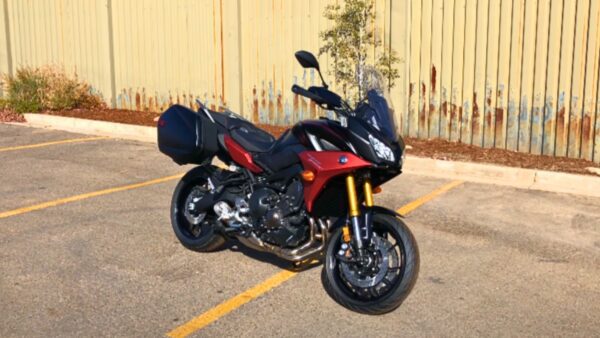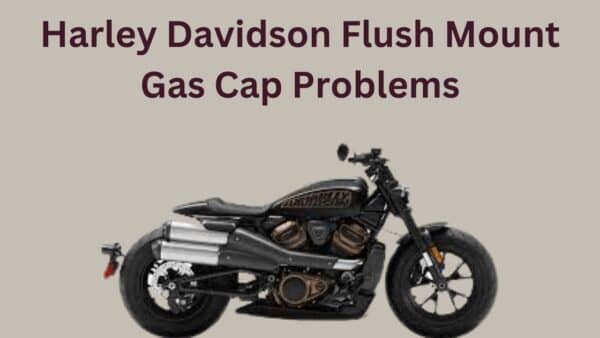Yamaha’s Tracer 900 GT stands as a popular choice among motorcycling enthusiasts, revered for its invigorating performance.

Yet, even the finest machines are not immune to issues.
In this article, we’ll explore some common problems that riders of the Tracer 900 GT may encounter, and provide solutions.
Let’s begin!
Yamaha Tracer 900 GT Problems
Yamaha Tracer 900 GT problems are poor brake performance, excessive clutch noise, motorcycle clutch slipping, stutters repeatedly, windshield stability issues, accessory port power issues, transmission failure, and vibrations at high speed.
1. Poor Brake Performance
Owners of the Yamaha Tracer 900 GT have reported that over time the brakes may start to perform less effectively.
This issue can make the brakes feel less responsive when you press them.
There are several reasons for this problem. It could be due to worn brake pads, old brake fluid, or air trapped in the brake lines.
To solve this issue:
- You should check the brake pads. If they are thin, replace them with new ones.
- If the brake fluid hasn’t been changed in a while or looks dirty, it’s time for new fluid. As a fresh brake fluid can improve performance.
- Also, bleed the brakes to remove any air in the lines, as this can also restore the proper feel of the brakes.
2. Excessive Clutch Noise
This noise often happens due to wear and tear on the clutch components, such as the clutch plates or springs, which can become worn or damaged over time.
Another reason for the noise could be an improper adjustment of the clutch cable, which needs the right tension to operate smoothly.
To solve these problems, inspect the clutch plates and springs for wear. If they are worn out, you can replace these parts to eliminate the noise.
You should also check the clutch cable’s adjustment. If it’s too tight or too loose, it can cause issues, so ensure to adjust it according to the manufacturer’s specifications.
Lastly, proper maintenance and handling of the clutch can prevent these noises and ensure the motorcycle operates as quietly as possible.
3. Motorcycle Clutch Slipping
It is when you give the bike some gas, but instead of going faster, the engine revs up, and the bike doesn’t really respond as it normally would.
This can happen for several reasons. The clutch plates might be worn out or covered in oil, the springs could be weak, or the cable might need adjusting.
To fix this issue, you’ll need to check the cable tension. If the cable isn’t adjusted right, the clutch might not fully engage.
You can try tightening it according to the bike’s manual. If that doesn’t solve the problem, you might need to replace the clutch plates or springs.
Related: Yamaha Bolt Problems
These are parts that wear down over time, especially with lots of riding or heavy use.
The clutch plates or springs replacement isn’t too complicated if you’re handy with tools and follow a good guide.
You’ll need to remove the clutch cover and take out the old plates or springs to put in new ones.
4. Bike Stutters Repeatedly
Bike stuttering is like when your motorcycle starts to hiccup or jerk while you’re riding it. But why does this happen?
It could be because of issues with the fuel system or perhaps spark plugs that aren’t working right.
Imagine the fuel system as the bike’s lungs, breathing in the energy it needs. If those lungs aren’t clear, the bike can’t breathe properly, and you feel it stutter.
So, what can you do about it? First, you should change the fuel filter; it’s like giving your bike a new breath of fresh air.
Also, check the spark plugs – those are like the bike’s heartbeat. If they’re dirty or damaged, the bike won’t run smoothly.
You can clean or replace them and see if that fixes the problem. And don’t forget about the fuel quality itself.
Because bad gas can make your bike feel sick. You should use clean, high-quality fuel to keep it running happily.
5. Windshield Stability
Some riders may find that at high speeds or during windy conditions, the windshield can vibrate excessively, which distracts the rider and reduces visibility.
The root cause of this issue usually lies in the mounting system not being stiff enough to hold the windshield firmly in place.
To resolve this problem, you can opt for aftermarket solutions that include sturdier brackets or additional supports designed to minimize movement.
An alternative solution is to replace the original windshield with one that has a more aerodynamic design, which can reduce the vibration due to wind resistance.
You should look for a windshield that balances improved stability with the bike’s aesthetics and visibility.
6. Accessory Port Power Issues
This problem could be due to several reasons such as a blown fuse, loose connections, or a malfunctioning accessory relay.
First, you should check the fuse that corresponds to the accessory ports. If the fuse looks burned or damaged, replace it with one of the same amperage rating.
If the fuse is fine, ensure that all connections to the port are secure and free of corrosion, which can disrupt power flow.
In the case of a suspected relay issue, you should identify and replace the faulty relay to restore function to the power ports.
Moreover, you should always disconnect the battery before attempting any electrical work to prevent any electrical issues.
7. Transmission Failure
This problem can manifest as difficulty in changing gears, strange noises from the gearbox, or the motorcycle refusing to engage or stay in gear.
The reasons for transmission issues can be lack of proper lubrication, wear and tear of gears and clutch components, or use of incorrect transmission fluid.
To resolve this, you should ensure the transmission fluid is at the correct level and replaced with the right type as recommended.
Regular maintenance checks can also help spot early signs of wear or damage so that small issues can be addressed before they lead to transmission failure.
In case of severe transmission issues, repair or replacement of certain parts may be necessary.
8. Vibration at Highway Speeds
Sometimes owners reported vibrations felt through the handlebars or foot pegs when cruising at highway speeds.
This issue can be due to a variety of factors, such as unbalanced tyres, wheel alignment, or uneven wear of the tyres.
To resolve this you should ensure the wheels are balanced correctly. If the tyres are old or worn unevenly, you should replace them.
Moreover, you should regularly check on the alignment to prevent this issue.
You should also check the condition of the bearings and suspension components, as they can contribute to vibrations if they’re worn out.
Lastly, you should consider adjusting the suspension settings to suit your weight and riding style.
Yamaha Tracer 900 GT User Review
The Yamaha Tracer 900 GT has gained a reputation as a versatile sport-touring motorcycle that strikes a perfect balance between everyday practicality and touring capability.
This bike has proven its strengths in several key areas, with almost a year of ownership and nearly 4,000 miles on the clock.
Firstly, its size and the inclusion of manufacturer hard cases make it highly practical for daily use, providing ample storage space without the need for additional bags.
The Tracer 9 GT’s nimbleness and responsiveness, particularly in traffic, are highlighted as significant advantages.
In terms of comfort, the bike offers adjustable ergonomics, a plush seat, and a well-proportioned handlebar, ensuring a comfortable riding experience.
Also, features like the adjustable windscreen and hand guards further enhance comfort and protection, especially in colder weather.
On the performance front, the 890cc inline-triple engine delivers impressive torque and power, accompanied by the convenience of an electronic quick-shifter.
Fuel economy stands at around 32 mpg, providing a decent range with the 5-gallon fuel tank.
The new model’s higher price is justified by its comprehensive features like heated grips, cruise control, and LED cornering headlights.
Yamaha Tracer 900 GT Technical Specifications
Here are the Yamaha Tracer 900 GT technical specifications:
| Specification | Detail |
| Engine Type | Off-Road, Touring |
| Displacement | 847 cc |
| Maximum Power | 113.4 hp |
| Maximum Torque | 87.5 Nm |
| Fuel Tank Capacity | 18.0 L |
| Cooling System | Liquid Cooled |
| Fuel Injection | Yes |
| Compression Ratio | 11.5:1 |
| Bore x Stroke | 78 mm x 59.1 mm |
| Transmission | Manual |
| Drive Type | Chain Drive |
| Clutch Type | Wet, Multi-Plate |
| ABS | Yes |
| Traction Control | Yes |
| Riding Modes | Off Road, Touring |
| Length | 2160 mm |
| Width | 850 mm |
| Height | Not specified |
| Wheelbase | 1500 mm |
| Ground Clearance | 135 mm |
| Top Speed | 160 kmph |
References:

Ahtsham Younas is a passionate blogger and content writer. He loves to ride motorcycles and learn the mechanical process behind the motorcycles.
He has been writing articles in the motorcycle industry since 2019 and has learned many things about motorbike niches.


